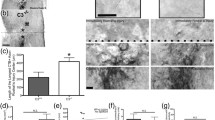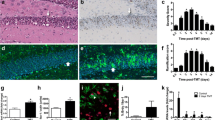Abstract
In a previous study, we found immunoreactivity for complement factors C3, C3d, and C4d, as well as endogenous IgG in the hypoglossal nucleus following hypoglossal nerve transection, suggesting that activation of the complement cascade had taken place in the vicinity of the axotomized motorneurons. In the present study, we found increased immunoreactivity for complement factor C1 and C1q in reactive microglia, indicating an increased potential for initiation of the classical pathway by binding of IgG to C1q. Furthermore, we found immunoreactivity for C9, which contributes to the formation of C5b-9, the final lytic product of the complement cascade close to the axotomized neurons and perineuronal glia. In addition, immunoreactivity and mRNA labeling of sulfated glycoprotein (SGP-2), putative complement inhibitor, was increased in a subpopulation of the axotomized motorneurons. SGP-2 immunoreactivity was also increased in astroglial cells ipsilateral to the nerve injury. The results lend further support to the hypothesis that the complement cascade is activated in the vicinity of axotomized neurons, which in turn may be protected by complement inhibitors. The balance between activation of complement and complement inhibitors might have an impact on the degenerative components of the axon reaction and, in particular, the events leading to nerve cell death.
Similar content being viewed by others
References
Agostini A., Cicardi M., Gardinali M., and Bergamaschini L. (1992) The complement system.Int. J. Immunopathol. Pharmacol. 5, 123–130.
Aldskogius H. and Svensson M. (1993) Neuronal and glial cell responses to axon injury, inAdvances in Structural Biology, vol. 2 (Malhotra S. K., ed.), JAI, Greenwich, CT, pp. 191–223.
Banati R. B., Gehrmann J., Schubert P., and Kreutzberg G. W. (1993) Cytotoxicity of microglia.Glia 7, 111–118.
Boje K. M. and Arora P. K. (1992) Microglial-produced nitric oxide and reactive nitrogen oxides mediate neuronal cell death.Brain Res. 587, 250–256.
Brown E. J. (1991) Complement receptors and phagocytosis.Curr. Opinion Immunol. 3, 76–82.
Brück W. and Friede R. L. (1991) The role of complement in myelin phagocytosis during PNS wallerian degeneration.J. Neurol. Sci. 103, 182–187.
Collard M. W. and Griswold M. D. (1987) Biosynthesis and molecular cloning of sulfated glycoprotein 2 secreted by rat Sertoli cells.Biochemistry 26, 3297–3303.
Day J. R., Laping N. J., McNeill T. H., Schreiber S. S., Pasinetti G., and Finch C. E. (1990) Castration enhances expression of glial fibrillary acidic protein and sulfated glycoprotein-2 in the intact and lesion-altered hippocampus of the adult male rat.Mol. Endocrinol. 4, 1995–2002.
Duguid J. R., Bohmont C. W., Liu N., and tourtellotte W. W. (1989) Changes in brain gene expression shared by scrapie and Alzheimer disease.Proc. Natl. Acad. Sci. USA 86, 7260–7264.
Esser A. F. (1991) Big Mac Attack: complement proteins cause leaky patches.Immunol. Today 12, 316–318.
Frank M. M. and Fries L. F. (1991) The role of complement in inflammation and phagocytosis.Immunol. Today 12, 322–326.
Garden G. A., Bothwell M. and Rubel E. W. (1991) Lack of correspondence between mRNA expression for a putative cell death molecule (SGP-2) and neuronal cell death in the central nervous system.J. Neurobiol. 22, 590–604.
Giulian, D. (1993) Reactive glia as rivals in regulating neuronal survival.Glia 7, 102–110.
Giulian D., Robertson C. (1990) Inhibition of mononuclear phagocytes reduces ischemic injury in the spinal cord.Ann. Neurol. 27, 33–42.
Giulian, D., Vaca, K., Corpuz, M. (1993) Brain glia release factors with opposing actions upon neuronal survival.J. Neurosci. 13, 29–37.
Giulian D., Chen J., Ingeman J. E., George J. K., Noponen M. (1989) The role of mononuclear phagocytes in wound healing after traumatic injury to adult mammalian brain.J. Neurosci. 9, 4416–4429.
Graeber M. B., Streit W. J., and Kreutzberg G. W. (1988) Axotomy of the rat facial nerve leads to increased CR3 complement receptor expression by activated microglial cells.J. Neurosci. Res. 21, 18–24.
Hänsch G. M. (1992) The complement attack phase: control of lysis and nonlethal effects of C5b-9.Immunopharmacology 24, 107–117.
Jenne D. E. and Tschopp J. (1989) Molecular structure and functional characterization of a human complement cytolysis inhibitor found in blood and seminal plasma: identity to sulfated glycoprotein 2, a constituent of rat testis fluid.Proc. Natl. Acad. Sci. USA 86, 7123–7127.
Jones J., Laffafian I., and Morgan B. P. (1990) Purification of C8 and C9 from rat serum.Complement Inflamm. 7, 42–51.
Kinoshita T. (1991) Biology of complement: the overture.Immunol. Today 12 291–295.
Lachmann P. J. (1991) The control of homologous lysis.Immunol. Today 12, 312–315.
Lees G. J. (1993) The possible contribution of microglia and macrophages to delayed neuronal death after ischemia.J. Neurolog Sci. 114, 119–122.
May P. C. and Finch C. E. (1992) Sulfated glycoprotein 2: new relationships of this multifunctional protein to neurodegeneration.Trends Neurosci. 15, 391–396.
May P. C., Lampert-Etchells M., Johnson S. A., Poirier J., Masters J. N., and Finch C. E. (1990) Dynamic of gene expression for a hippocampal glycoprotein elevated in Alzheimer’s disease and in response to experimental lesions in rat.Neuron 8, 831–839.
McGeer P. L., Akiyama H., Itagaki S., and McGeer E. G. (1989) Immune system response in Alzheimer’s disease.Canad. J. Neurol. Sci. 16, 516–527.
McGeer P. L., Kawamata T., Walker D. G., Akiyama H., Tooyama I., and McGeer E. G. (1993) Microglia in degenerative neurological disease.Glia 7, 84–92.
McNeill T. H., Cheng M., Lampert-Etchells M., Finch C. E., and Pasinetti G. M. (1990) Induction of sulfated glycoprotein (SGP-2) gene expression in the striatum following cortical deafferentation.Soc. Neurosci. Abstr. 16, 1291.
Michel D., Chabot J. G., Moyse E., Danik M., and Quirion R. (1992) Possible functions of a new genetic marker in central nervous system: The sulfated glycoprotein-2 (SGP-2).Synapse 11, 105–111.
Morgan B. P. (1992) Effects of the membrane attack complex of complement on nucleated cells.Curr. Topics Microbiol. Immunol. 178, 115–140.
Morgan B. P. and Meri S. (1994) Membrane proteins that protect against complement lysis.Springers Seminars Immunopathol. 15, 369–396.
Murphy B. F., Kirszbaum L., Walker I. D., and d’Apice A. J. P. (1988) SP-40, 40, a newly identified normal human serum protein found in the SC5b-9 complex of complement and in the immune deposits in glomerulonephritis.J. Clin. Invest. 81, 1858–1864.
Pasinetti G. M. and Finch C. E. (1991) Sulfated glycoprotein-2 (SGP-2)_mRNA is expressed in rat striatal astrocytes following ibotenic acid lesions.Neurosci. Lett. 130, 1–4.
Pasinetti G. M., Johnson S. A., Rozovsky I., Lampert-Etchells M., Morgan D. G., Gordon M. N., Morgan T. E., Willoughby D., and Finch, C. E. (1992) Complement C1qB and C4 mRNAs responses to lesioning in rat brain.Exp. Neurol. 118, 117–125.
Piani D., Frei K., Do K. Q., Cuenod M. and Fontana A. (1991) Murine brain macrophages induce NMDA receptor mediated neurotoxicity in vitro by secreting glutamate.Neurosci. Lett. 133, 159–162.
Robinson A. P., White T. M., and Mason D. W. (1986) Macrophage heterogeneity in the rat as delineated by two monoclonal antibodies MRC OX-41 and MR OX-42, the latter recognizing complement receptor type 3.Immunology 57, 239–247.
Rosen H. (1990) Role of CR3 in induced myelomonocytic recruitment: Insights from in vivo monoclonal antibody studies in the mouse.J. Leukocyte Biol. 48, 465–469.
Stoll G., Schmidt B., Jander S., Toyka K. V., and Hartung H.-P. (1991) Presence of the terminal complement complex (C5b-9) precedes myelin degradation in immune-mediated demyelination of the rat peripheral nervous system.Ann. Neurol. 30, 147–155.
Streit W. J., Graeber M. B., and Kreutzberg G. W. (1988) Functional plasticity of microglia: A review.Glia 1, 301–307.
Svensson M. and Aldskogius H. (1992a) Evidence for activation of the complement cascade in the hypoglossal nucleus following peripheral nerve injury.J. Neuroimmunol. 40, 99–110.
Svensson M. and Aldskogius H. (1992b) The effect of axon injury on microtubule-associated protein MAP2 mRNA in the hypoglossal nucleus of the adult rat.Brain Res. 581, 319–322.
Svensson M. and Aldskogius H. (1993) Infusion of cytosine-arabinoside into the cerebrospinal fluid of the rat brain inhibits the microglial cell proliferation after hypoglossal nerve injury.Glia 7, 286–298.
Svensson M., Eriksson P., Persson J. K. E., Molander C., Arvidsson J., and Aldskogius H. (1993) The response of central glia to peripheral nerve injury.Brain Res. Bull. 30, 499–506.
Thanos S., Mey J., and Wild M. (1993) Treatment of the adult retina with microglia-suppressing factors retards axotomy-induced neuronal degradation and enhances axonal regeneration in vivo and in vitro.J. Neurosci. 13, 455–466.
Thery C., Chamak B., and Mallat M. (1991) Cytotoxic effect of brain macrophages on developing neurons.Eur. J. Neurosci. 3, 1155–1164.
Thomas W. E. (1992) Brain macrophages: evaluation of microglia and their functions.Brain Res. Rev. 17, 61–74.
Vaca K. and Wendt E. (1992) Divergent effects of astroglial and microglial secretions on neuron growth and survival.Exp. Neurol. 118, 62–72.
Yao J., Harvath L., Gilbert D. L., and Colton C. A. (1990) Chemotaxis by a CNS macrophage, the microglia.J. Neurosci. Res. 27, 36–42.
Author information
Authors and Affiliations
Rights and permissions
About this article
Cite this article
Svensson, M., Liu, L., Mattsson, P. et al. Evidence for activation of the terminal pathway of complement and upregulation of sulfated glycoprotein (SGP)-2 in the hypoglossal nucleus following peripheral nerve injury. Molecular and Chemical Neuropathology 24, 53–68 (1995). https://doi.org/10.1007/BF03160112
Received:
Accepted:
Issue Date:
DOI: https://doi.org/10.1007/BF03160112




